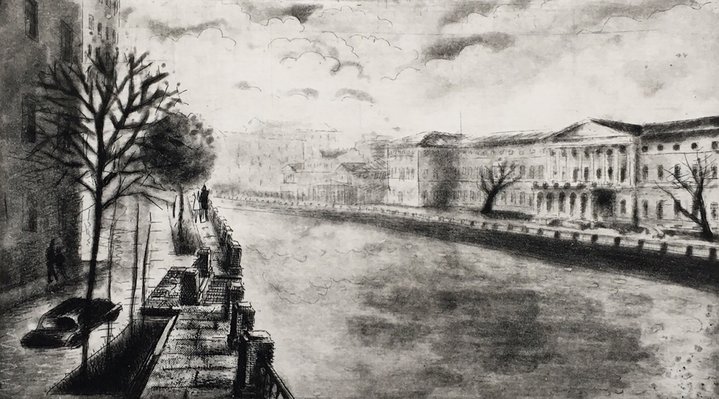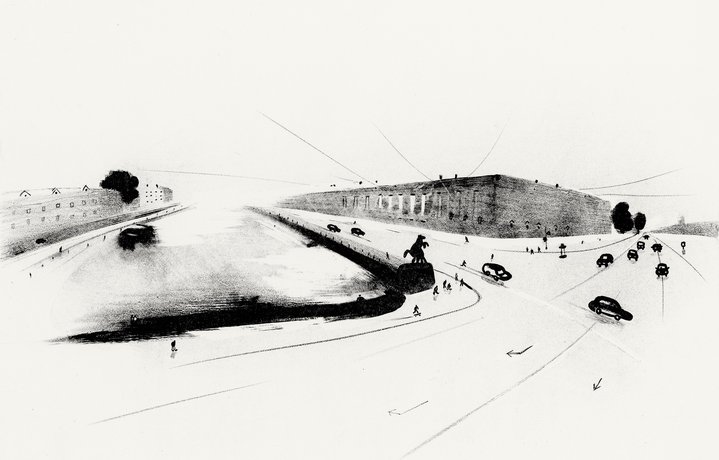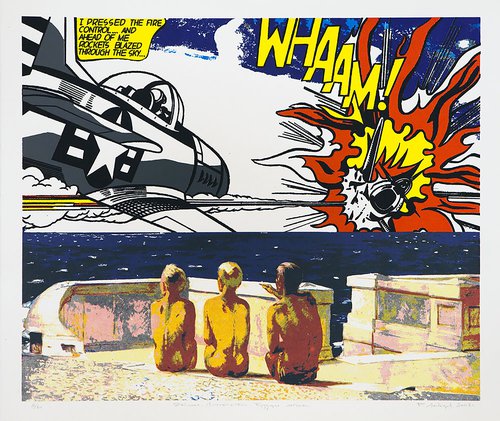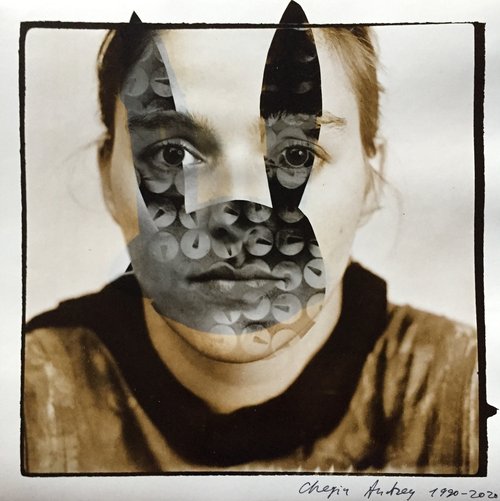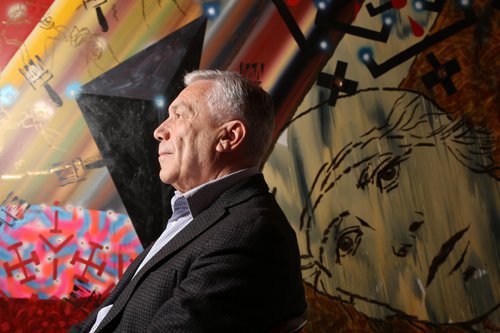Kirill Avelev, St.Petersburg’s prince of prints
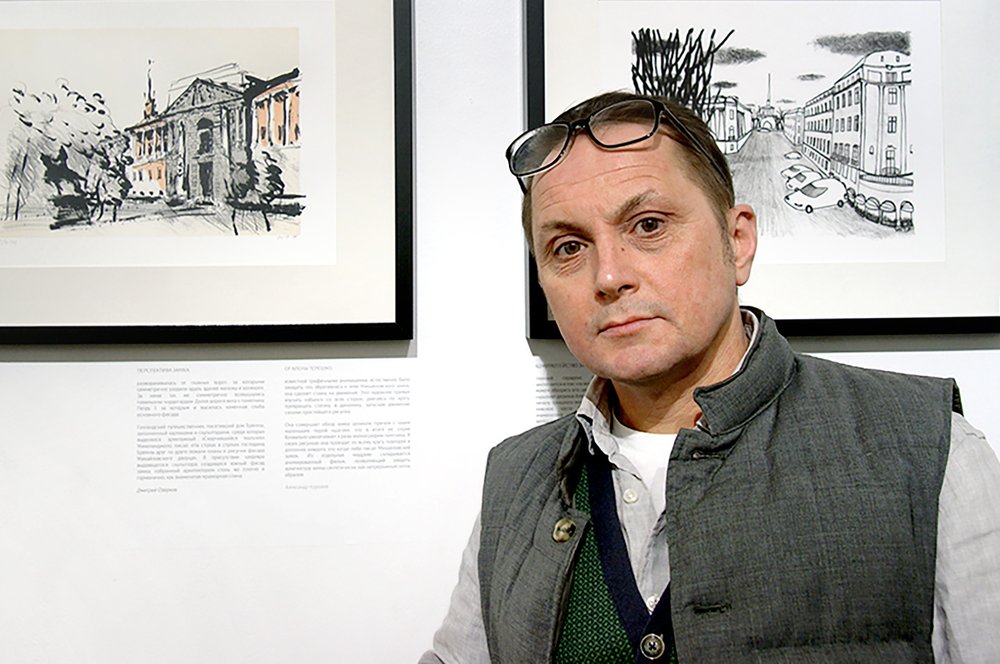
Kirill Avelev at the exhibition of graphics from his collection 'To the Architects of Our City' at KGallery. Photo by Nikolay Simonovsky
A Russian collector and publisher who has assembled an impressive collection of graphic works by artists from his city recently opened an exhibition in an artsy hotel close to his home, showing St. Petersburg at its best.
Kirill Avelev welcomes me into his snug apartment on a typical rainy afternoon in St Petersburg. The walls are lined with shelves crammed with folders containing works of art on paper. What remains of the small space is hung with framed drawings; operatic arias are wafting in the background. ‘There was once a French book shop in this building which Pushkin visited, but nobody knows now exactly where it was’ he comments by way of an icebreaker. It’s obvious that Avelev’s passion for collecting comes from his love for his own city, its history, its art treasures, and the elusive yet omnipresent ‘St.Petersburg myth’. When he started buying art in the late 1990s, his first acquisitions were cityscapes, such as etchings by Elena Novikova (b. 1958) he bought at a small gallery in the Letnyi Sad (Summer Garden), a historical park in the centre of St. Petersburg. Then, although his range of subjects grew wider to include everything from book illustrations to nudes, the artists were always from St. Petersburg. He was systematic about ensuring all important names from the city’s art scene were included in the collection. ‘I was fishing with a wide net, and artists whose works I did not buy frown at me even now’. And it was always graphics, works on paper, mostly black and white.
At first his preference for this medium came instinctively, but over the years everything just solidified and he came to a better definition of his initial attraction: ‘In terms of artistic language graphics are stricter, more concise, there is a leaning towards signs, a generalisation’, Avelev explains. ‘Graphic art can be compared with poetry, the right words are in the right order, nothing is superfluous, while painting is like a novel by Lev Tolstoy. For me, graphic are the quintessence of artistic expression because they are completely devoid of material’. He points towards a sketch of a nude by his favourite artist Pyotr Shvetsov (b. 1970) hanging by the dinner table in an opulent gilt frame. ‘Look at this… it’s drawn on a napkin!’.
Avelev first showed his collection to the public in 2001 and organised several shows at the city’s state and private museums and galleries from the Erarta Museum to the Manege exhibition hall. He had some private exhibitions in his own apartment. Avelev quickly lost interest in purchases from commercial galleries and began to visit artists’ studios. He enjoyed meeting and talking with artists and soon found himself going deeper and deeper into the world of graphic techniques. He was fascinated by the evolution of an idea from first draft to final result: the print. When acquiring a print, he tries to get hold of all the preliminary sketches as well. One of his collecting principles is ‘From Sketch to Print’. This is how his transformation from a collector to a publisher came about naturally. He managed to get hold of Alexander Florensky’s (b. 1960), original drawings for the legendary 1993 three-volume edition of Collected Works of Sergei Dovlatov, a renowned Russian émigré writer. This triple-decker was published in a vast number of copies, and every self-respecting family from the Russian intelligentsia used to own one. In 2008, Avelev came up with the idea of publishing the illustrations as a limited-edition set of silkscreen prints. Later, other projects followed, including an anniversary edition of Pyotr’s Shvetsov graphics. ‘I wanted to commemorate his 40th birthday and my 10th anniversary of collecting his work’, Avelev says.
Avelev found himself inadverently following in the footsteps of the great publishers of artist’s books such as Ilyazd (Ilya Zdanevich) and Ambroise Vollard. The next stage of his activities involved commissioning graphic works directly from artists to publish them as prints or limited-edition books. Over the last five to seven years he has shifted the focus of his collection to address what is often loosely referred to as the ‘St.Petersburgh myth’, the origins of which in the fine arts he traces to the Mir Iskusstva (World of Art) group of art nouveau artists in the early 20th century, who assembled around an eponymous magazine. An essay by the artist and art historian Alexander Benois (1870–1960) called ‘Beautiful Petersburg’ was published in the magazine in 1902. ‘This concept was totally new for its time’, Avelev explained. ‘Back then, St. Petersburg was the capital of an Empire, a city of police stations and army barracks. The aura of mystical beauty that surrounds it now and that we take for granted just did not exist then’. For years, Avelev explored how this myth continued to evolve in the works of St.Petersburg-Leningrad artists of different generations. To bring it up to date, he also asked several artists from the generation of millenials to contribute. He commissioned three of them to make series of graphic works dedicated to renowned 18th and early 19th century architects whose neo-classical ensembles define St.Petersburg. Asya Marakulina (b. 1988), Ivan Chemakin (b. 1986) and Alyona Tereshko (b. 1986) created a dialogue with Giacomo Quarenghi, Andreyan Zakharov and Vincenzo Brenna, respectively. The artists depicted the neo-classical St. Petersburg as envisioned by these architects, “la citta ideale”, an ideal city, unspoilt by the mindless construction and the urban planning mistakes of subsequent generations.
These prints were published as limited edition books, complemented with texts by leading art historians and art critics from the city. Some of the original drawings are now on view at the exhibition ‘Room K’ (K stands for ‘collector’ in Russian or Kirill) at the Wynwood hotel on the embankment along the Griboedov canal, close to Avelev’s apartment. With its own fast growing art collection, an ambitious exhibition programme and an artist residency project, this hotel has become one of the city’s hotspots for contemporary art since it opened in 2017. Currently artists-in-residence are invited to stay there and work on projects in their own rooms, but a separate area with spacious studios is about to open. Graphic works from Avelev’s collection are displayed in the hotel’s staircase where they can be viewed both by guests and visitors at any time of day or night, and a hidden part of the show, there is one work of art which is changed every day located in ‘Room K’ for unsuspecting guests to enjoy.







